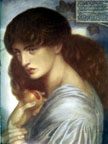As a painting that displays almost all of the characteristics of the second half of D.G. Rossetti's career, Proserpine is exemplary. Worked in colored chalks and featuring Jane Morris, the second great love of Rossetti's life, as the Underworld goddess Proserpina, the painting projects a mood of "dreamy sensuality" (Wood 96) and lends itself to interpretation in terms of the themes that occupied Rossetti throughout his lifetime.

Rossetti himself described the painting: Proserpina, he said, "is represented in a gloomy corridor of her palace with the fatal fruit in her hand" (Wildman 140). Her tilted head and curved arm holding the pomegranate form a smooth, almost completed ellipse, and the ivy in the background creates the same sort of graceful, unconnected curve, suggesting through visual imagery the connections he wished to create in his art between past and present, spiritual and sexual love, and the "personal unconscious" (Rossetti Archive, "Proserpina (for a picture)") and artistic expression. An incense burner beside her sends its curling gray smoke into the air in curls similar to those created by her masses of dark flowing hair and the folds of her simple gown. The gray of the smoke at first appears to match the color of the gown until the viewer realizes that, were it not for the dim of the surroundings, the dress would be pure white. The eyes that look upward in a downward tilted face imply a strong, poignant yearning for the world above Hades, especially if one notes the square of light from an unknown source that illuminates part of her face and the wall behind her. However, the pomegranate, held so close to her body, serves to remind her of the barrier that exists between her world and that of the light. The sonnet in the upper right corner fo the picture serves to intensify the mood and message created by the pictorial images.
Questions
1. During the second half of his career, Rossetti moved away from using watercolors and turned towards oils and chalks. Is the painting's message more or less effective in its use of colored chalk as a medium?
2. Rossetti also used his first great love, Elizabeth Siddal, extensively as a model. What kind of themes does he use Elizabeth to portray in other paintings? Do his paintings of Elizabeth and the themes she represents differ significantly from his works featuring Jane Morris?
3. In his prose ekphrasis of the painting, Rossetti says, "The ivy branch in the background may be taken as a symbol of clinging memory"(Rossetti Archive, "Proserpina (for a picture)"). Is there any other explicit symbolism in the painting? Is there any religious imagery, or had it completely disappeared from his works by the time of this picture?
4. Does Rossetti actually create the sort of thematic connections he intended? Do the uncompleted elliptical forms say anything about Rossetti's view of his own work?
Related Materials
Bibliography
Wildman, Stephen. Rossetti, 1990, p. 140.
McGann, Jerome J., ed. The Rossetti Archive. Accessed 3 October 2004. http://jefferson.village.virginia.edu:2020
Wood, Christopher. The Pre-Raphaelites. George Weidenfeld and Nicholson: 1981.
Last modified 27 June 2020